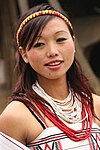Mishmi people
They are located in the northeastern tip of the central Arunachal Pradesh in Upper and Lower Dibang Valley, Lohit and Anjaw Districts, all bordering southern Tibet in northeast India.The last coordinated effort to understand the Mishmi occurred in the year 1985, after the Chinese academy of social sciences dispatched a total of four anthropologists hailing from the institute of Ethnology and Anthropology.[3] (Aiyadurai & Lee, 2018) note that instead, "...they are classified as an 'unidentified ethnicity' or 'others', largely due to the nature of a category for characterizing only a handful of people in contemporary China.[citation needed] The beginning of British rule in India with regards to the hill people was generally one of non-interference due to a fear of rebellion from these groups.[3] Officially, it was not until the murder of Noel Williamson (a political officer) and Dr Gregorson (a tea planter and doctor) that the British began to clamp down on the Mishmi in a show of force and dominance.

Naga woman
Arunachal PradeshTibet Autonomous RegionNorthern Mishmi languagesSouthern Mishmi languagesMandarinAnimismTibetansSino-Tibetan peopleChineseStandard MandarinHanyu PinyinTraditional ChineseMishmi HillsZayu CountyIdu MishmiDigaroMiju MishmiUpper Dibang ValleyLohit districtLohit riversDibang Valleynortheast IndiaLhoba peopleDerung peopleHimalayasPeople's Republic of ChinaWikisourceNew International EncyclopediaEthnic groups of ChinaSino-TibetanSiniticHan ChinesesubgroupsCaijiaChuanqingLongjiaWaxiangLolo-BurmeseAchangKucongLaomianLaopinQixingminQiangicGyalrongTibeticSherpaJingpoDerungAustroasiaticVietnameseTa'angAustronesianGaoshanFilipinoUtsulsHmong-MienMongolicMongolsDongxiangMonguorYugursEasternHamniganKangjiaKhatsoSogwo ArigKra–DaiZhuangBouyeiTai LueTai NuaMaonanBuyangQabiaoTungusicManchusEvenksOroqenTurkicUyghursKazakhsKyrgyzSalarsWesternUzbeksTatarsAltaiansFuyu KyrgyzIli TurksTuvansIndo-EuropeanPamirisTajiksWakhisRussiansArmeniansIraniansNepalisKoreansChaoxianAfrican ChineseIndiansJapaneseKaifeng JewsMacaneseNivkhsPakistanisOverseas ChineseAlgeriaMoroccoCape VerdeNigeriaSenegalEthiopiaTanzaniaUgandaCameroonDemocratic Republic of CongoRepublic of CongoAngolaBotswanaLesothoMadagascarMalawiMauritius